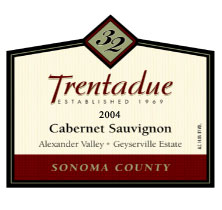 |
|
Wine Details
Price:
$22.00 per bottle
Description:
The 2004 vintage started with record rainfall with rain in the late spring and through the bloom period for grapes. The wet and cold spring resulted in poor pollination and ultimately in fewer grapes on the vines. The reduced crop delivered high quality fruit and excellant wines from our Estate in Geyserville. Our 2004 Cabernet Sauvignon was picked relatively early due to early ripening of fruit. All grapes were picked at night during the coolest temperatures in order to preserve freshness and the intensity of the grape aromas. The grapes were destemmed and partially crushed with a high percentage of whole berries. After cold-soaking the fruit for several days, the must was inoculated with several different types of yeast and the wine macerated in average of 22 days on the skins post fermentation. After 16 months of barrel aging in 20% new French and other European oak barrels, the final blend was lightly fined with egg whites and bottled. This wine is a classic example of Alexander Valley cabernets, showing seductive sweet plums and ripe dark cherry aromas with layers of earth, dust, forest floor, herbs and cedar. The mouth feel is medium to full with balanced acidity and firm, slightly dusty tannins. Thsi wine will age well for the next 5-8 years. Cheers! Miro Tcholokov - Winemaker
Purchase this wine
|
|
Varietal Definition
Cabernet Sauvignon:
Cabernet Sauvignon is the most widely planted and significant among the five dominant varieties in France’s Bordeaux region, as well as the most successful red wine produced in California. Though it was thought to be an ancient variety, recent genetic studies at U.C. Davis have determined that Cabernet Sauvignon is actually the hybrid offspring of Sauvignon Blanc and Cabernet Franc. Cabernet Sauvignon berries are small with black, thick and very tough skin. This toughness makes the grapes fairly resistant to disease and spoilage and able to withstand some autumn rains with little or no damage. It is a mid to late season ripener. These growth characteristics, along with its flavor appeal have made Cabernet Sauvignon one of the most popular red wine varieties worldwide.
|
Cabernet Franc:
Cabernet Franc is an accessible, spicy, herbal, dark blue grape variety that is often compared to Cabernet Sauvignon. Cabernet Franc tends to be softer and has less tannin than Cabernet Sauvignon, although the two can be difficult to distinguish. Sometimes the French refer to Cabernets, which could mean either of the two grapes. Its typical aromas include an herbaceous and pronounced peppery nose, even in ripe fruit, and something eerily like tobacco. The Cabernet Franc ripens at an earlier stage, which gives it reason to exist in the Bordeaux area. In the Loire, where we find it a lot, it gives a clear red fresh and fruity wine.
|
Merlot:
Merlot is known as a Noble Bordeaux varietal. Although it came to France in the first century, it was not named until the 1880s. Merlot was originally used only for blending, as it is soft and compliant, very useful in softening other Bordeaux wines like Cabernets. Recently in California and Chile it became popular as a 100% varietal wine. Merlot tends to be easier to grow in a variety of soil conditions and is harvested earlier in the year than Cabernet. Although most Merlots are made to be drunk earlier, there are many with complexities of a Cabernet. Flavors of plum, black cherry, violet, chocolate and orange pair well with rich, red pasta dishes, hearty chicken dishes, and any beef combination that you fancy. The perfect match of course is chocolate. Not only does the chocolate compliment the wine and vice-versa, but the essence of both flavors linger eternally.
|
|